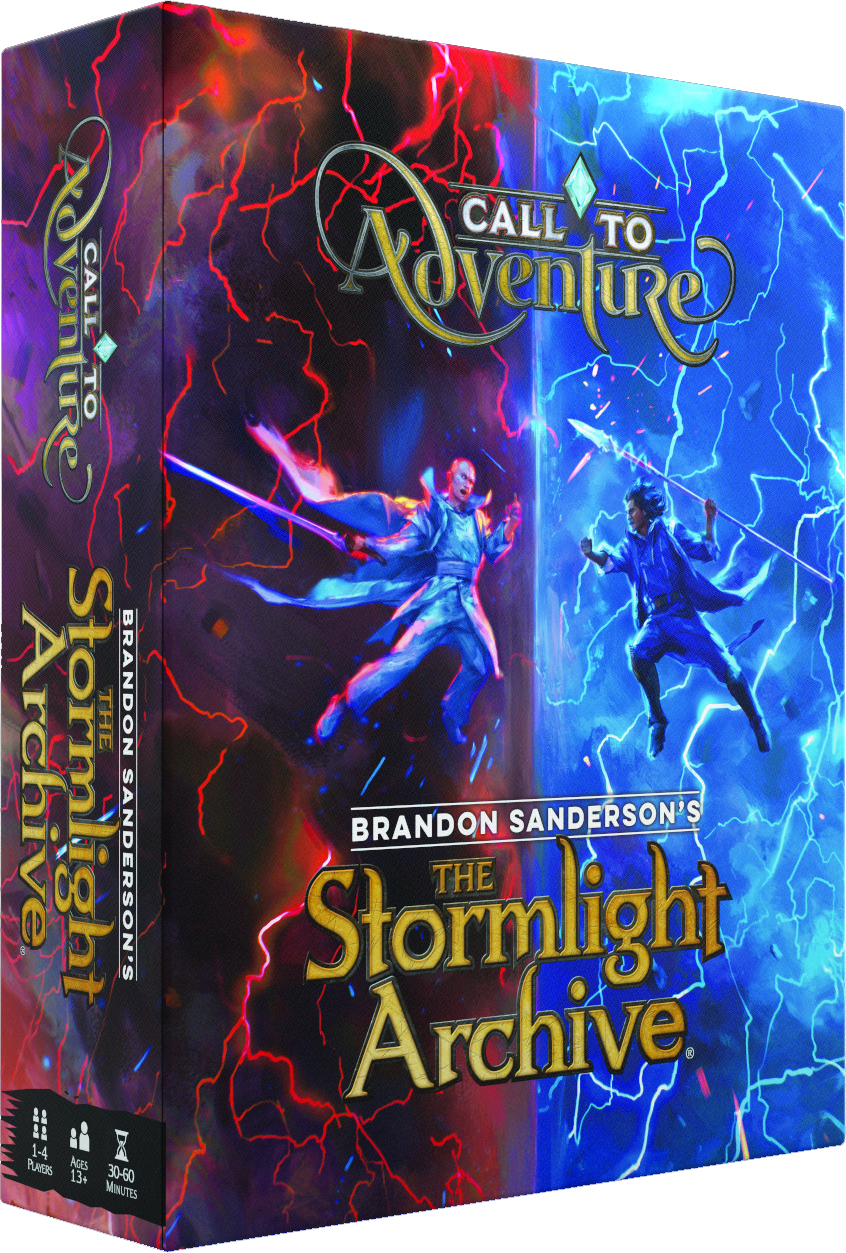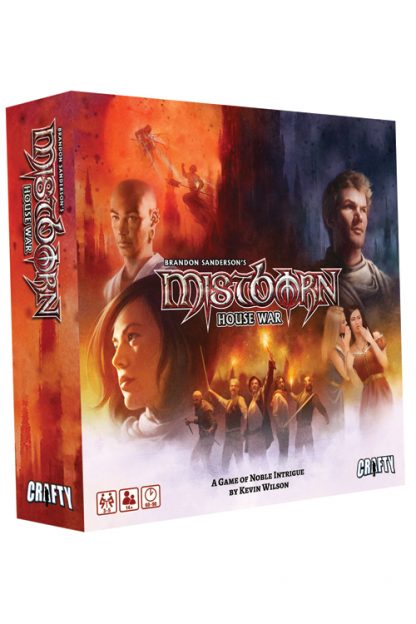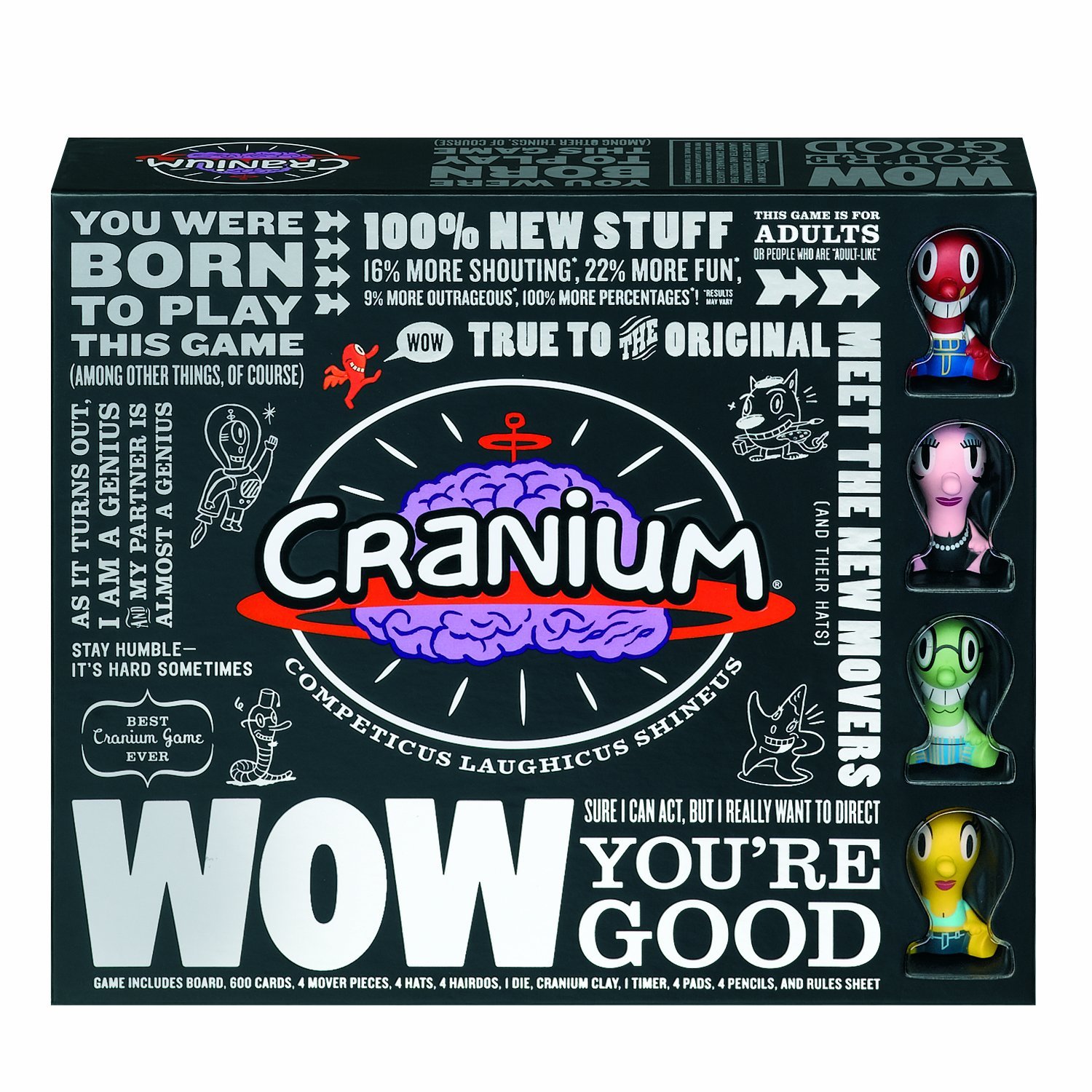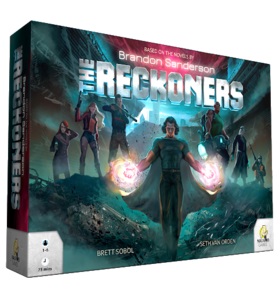If you’ve wandered by the fantasy section of any bookstore for the last twenty years, odds are good you’ve seen at least one title (usually a hefty volume) bearing Brandon Sanderson’s name along the spine. These epic adventures have been expanding to the tabletop in recent years, enticing you into their arms with various ways to get Sanderson’s Cosmere multiverse to your tabletop.
So whether you’re deep into the Stormlight Archive or prefer the magical skullduggery of Mistborn, read on to find the best Brandon Sanderson board games and bring your favorite fantasy series to your tabletop.
Adventure in the Stormlight Archive
Reduce Call to Adventure (Johnny O’Neal, Christopher O’Neal) to a brief comparison, and you might wind up with Roll Player meets Arkham Horror in an epic fantasy setting. Though not as tough or complex as the latter, nor as reliant on dice as the former, Call to Adventure nonetheless pairs character development with storytelling, abounding in skill checks and choices as you take on adversaries, challenges, and quests en route to a conclusion all within a single session, generally with the goal of amassing more than 30 points through completing those quests, defeating enemies, and so on.
 That’s a strong word salad there, one Call to Adventure backs up with a slew of cards and, rather than dice, a fun system called ‘rune rolling’, whereby you toss Domino-esque tiles and use their cryptic symbols to divine success, failure, or something in between. You’ll be casting these runes to drive your character’s story, either deciding whether a lock gets picked or a demon gets their just desserts. These obstacles won’t randomly appear, either, which brings us to Call to Adventure’s guiding principle:
That’s a strong word salad there, one Call to Adventure backs up with a slew of cards and, rather than dice, a fun system called ‘rune rolling’, whereby you toss Domino-esque tiles and use their cryptic symbols to divine success, failure, or something in between. You’ll be casting these runes to drive your character’s story, either deciding whether a lock gets picked or a demon gets their just desserts. These obstacles won’t randomly appear, either, which brings us to Call to Adventure’s guiding principle:
This is a story centered on your character, and your choices matter.
Call to Adventure presents you options on every turn, namely whether to develop a trait for your character (like Vengeful, or, for the dull among you, Studious) or take on a challenge, like drive back the demon army (perfect for your studious character). If attempting something dangerous, you’ll cast those runes, hopefully avoid catastrophic failure, and add that completed challenge to your personal player board. Your story, in other words, grows with every round, giving you a tale to look back on at the game’s end.
One that Sanderson would approve of?
Probably, given the broad range on display. You can be good, evil, or something in between. Call to Adventure supports co-op play (and solo) too, where you’ll attempt to create a more compelling legend than the AI-controlled adversary. The flexibility here is a nice touch, as Call to Adventure can get you a complete adventure in an hour or less, which is a nice spot for solitaire games or an evening affair with family.
Now, should you go prowling for Call to Adventure editions, you’ll find Sanderson in the Stormlight Archive edition, which blends that world’s bespoke elements into the game’s narrative core. For a more generalized experience, the earlier Call to Adventure gives you a more neutral adventure, better for broad audiences.
And, should you prefer Patrick Rothfuss instead, Call to Adventure: Name of the Wind has you covered.
Deckbuilding, Sanderson Style
As a setting, Mistborn’s had its share of tabletop titles. Now John D. Clair is taking his deck-building talents to Sanderson’s story, serving up an allomantic shuffling battle in Mistborn: The Deckbuilding Game. Unlike other recent IP deck-builders like Avatar: Aang’s Destiny, Mistborn isn’t a campaign co-op, instead pitting you against one another in a fast, furious, elemental battle.
Innovative delights banish the been-there-done-that dust so often found in deck-builders, with Clair shuttling in nifty tricks to nearly every phase. Take your characters – you’ll earn abilities, beginning with minor buffs and leveling up as the game continues, culminating in a powerful option to burn a market card for a one-time use of its ability. Or being able to spend cards to boost others sharing their element, a way to keep ragged cards relevant. You won’t, in other words, just be racing to slim down your deck, as you might find yourself without the card-spend burst to pull off the biggest attacks.
words, just be racing to slim down your deck, as you might find yourself without the card-spend burst to pull off the biggest attacks.
And you’ll want to be attacking, because Mistborn demands you destroy players to win. Sure, you could complete missions, building enough talent and reputation to win, but doing such a thing’s just going to put a target on your back. Better, instead, to find some atium and blow your opponents away.
Player elimination in games is always a tad dicey, but Mistborn’s rapid pace and sub-hour playtime, particularly with veterans, ensures any mistborn who proves less than god-like won’t be waiting long for another go-round. Instead, the game encourages going after your strongest rivals rather than ganging up on the weak, meaning endgames tend to be filled with cataclysmic turns popping off one after the next.
Solo and Co-op modes exist too, if you prefer spending your magical energies bringing the Lord Ruler to heel. Challenging, though not cumbersome to manage, playing these variants is the frosting on the Mistborn cake: fun if that’s what you’re looking for, but best served up with Sanderson devotees only.
The metal-burning competitive mode is where Mistborn shines, and where it’ll earn its spot in your collection.
A Coop Challenge That Plays Fast, Beats You Faster
Simultaneous play is a beguiling label, offering zero downtime and absolute chaos as players wildly roll dice, shout answers, or discuss strategy. Whether it’s  a party like Cranium or a space wasp simulator like Sidereal Confluence, diving into real-time gaming is an experience not to be missed, and The Reckoners (Brett Sobol, Seth Van Orden), themed off of Brandon Sanderson’s series of the same name, does it well.
a party like Cranium or a space wasp simulator like Sidereal Confluence, diving into real-time gaming is an experience not to be missed, and The Reckoners (Brett Sobol, Seth Van Orden), themed off of Brandon Sanderson’s series of the same name, does it well.
In The Reckoners, you and up to four other friends will be going up against the nefarious Steelheart, a foe too dangerous to walk up and slug bar-fight style. Instead you’ll have to find his weaknesses while keeping his super-powered henchmen, labeled Epics, at bay. With your trusty dice, you’ll all start every round chucking those cubes until you’ve spent them on a few actions, having to weigh coming doom at the Epics’ hands vs getting closer to defeating Steelheart. Those actions might be bashing in enemies, conducting research, running around scoring treasure, or any of a handful of other options (including, like wishing for more wishes, finagling additional actions).
You’ll need to use all these options in concert with one another, as going off on your own might pass muster early on, but problems will mount fast if players don’t band together. As you can cluster up to six around this monster, yet still keep it to under two hours, The Reckoners expands to fit your group while demanding focus.
See, every Epic left alive is going to use their abilities to make your life miserable, whether by damaging and harassing you or buffing themselves, and then they’ll get even stronger, so ignoring the lesser enemies, much like your household chores, will come back to bite you.
The Reckoners falls into that cooperative sweet zone, where difficulty is high, discussion is imperative. Trying to corral everyone’s actions while rolling your own isn’t impossible, but quarterbacking The Reckoners would be a test for even the pushiest puppeteers. Jimmy might have a great idea, but you can go right ahead and ignore it, a bold move that would draw gasps at the Pandemic table yet thrives here. At least until the Epics turn you to ash.
own isn’t impossible, but quarterbacking The Reckoners would be a test for even the pushiest puppeteers. Jimmy might have a great idea, but you can go right ahead and ignore it, a bold move that would draw gasps at the Pandemic table yet thrives here. At least until the Epics turn you to ash.
At least The Reckoners looks and feels great while grounding your band to dust. We’re talking dual-layer boards, special dice, art splashed over everything, and so on. This is a premium product that’ll give back to fans of Sanderson’s books (or create new ones), and while it’s not a small game, you’ll be happy covering your table in such an obvious labor of love.
So if you’re tired of slower cooperative games, The Reckoners is one to dig into. Its theme is on point, it plays fast, and you’ll find wins aren’t all that easy to come by. Winning features, in my book anyway.
Finale
It’s tough to go wrong with Brandon Sanderson board games, as, just like his Cosmere setting, you have a whole lot of cool choices (plus a tabletop RPG coming soon through crowdfunding). A Call to Adventure gives you the story, Mistborn: The Deck-building Game brings the battle, and The Reckoners presents a dire, low-downtime puzzle. Not too bad.
Now, if only we could get a Mistborn movie…
Check out our previous article here!
